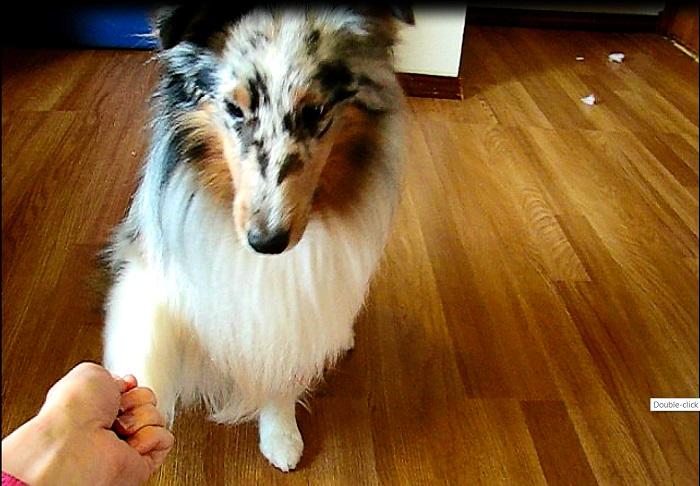There is just something too cute about a dog waving. As demonstrated in this video, you can teach your dog to wave with each paw, or both paws at once.
The best part about wave? It’s fairly easy to teach and most dog enjoy doing it.
Teach The Trick
Step 1
Make sure you have treats and a clicker (if you use one) on hand.
- Sit or stand facing your dog and put one of your hands in a fist in front of your dog – have it a bit above the ground. This will depend on the size of your dog; you want it to be at a height that is comfortable for your dog to reach with his paw.
- Have your treats and clicker in your other hand.
- Most dogs will paw at your hand, thinking there is something in it. Click or use your marker word (yes, good, etc) and reward as soon as your dog has his paw up, reaching toward your hand, but has not actually touched it.
- If your dog does touch your hand, do not mark/reward.

NOTE: if your dog is pawing the air but his paw is not as high as you would like, try moving your fist a bit higher up and see if that makes your dog raise his paw more.
Step 2
Once your dog is repeatedly putting his paw in the air, but has stopped trying to touch your hand (you will see him stop “following through” this is paw, you can try removing your fist from the picture.
Two ways to do this:
- Remove your hand completely – some dogs will “have it” and will keep pawing the air even if you just remove your hand.
- Fade your fist – others, you will have to fade your fist by slowing moving it further and further away from your dog while he is still performing the wave.
Step 3
Add a cue.
Once your fist is gone and your dog is “waving” (holding his paw up) you can add a cue. Some people use a hand signal (they wave and the dog waves back) and other’s just use a word. One of my dog’s actually had the fist being held up as the signal to wave (so I could ask her to wave without other people knowing I was cuing her – made it seem like she was waving to them on her own and guests loved it).
Tips
If your dog won’t go for your hand, try using an object like a paw pod, book, empty container, etc.

If your dog doesn’t want to lift his paw, start with the item on the ground and mark/reward any paw movement of ONE paw. Don’t mark/reward when he moves either front paw or you will confuse him.
Building on the Wave
Once you have the basics down you can teach him to wave with the other paw if you like. At first, this may be hard for your dog, since most dogs are dominant with one paw and that will be the one they offered in the first place. So, you are going to want to go back to the beginning and do not use the cue (which your dog will associate with his other paw).
Once he is waving with both, you can use a different cue, such as “other paw” or teach him to mirror your hand signal (you wave with your left hand, he waves with his right and vice versa).
Modified Waves
- You can combine a “sit pretty” with a wave, as long as your dog has the balance and muscles to sit up that long.
- Teach your dog to wave with both paws at once for a “beg.”
- Teach him to hold his paw in the air mid-wave if you will, so it looks more like a salute.
Just like with any trick, the sky’s the limit when it comes to making it your own. Have fun and be creative – you may be surprised what you come up with!
[ilds above]
About the Author
Based in Wilsonville, Ore., animal lover Kristina N. Lotz is a Certified Professional Dog Trainer – Knowledge Assessed (CPDT-KA) and a member of the Dog Writers Association of America. She is the founder of A Fairytail House. In her spare time, she trains and competes in a variety of performance events with her Shetland Sheepdogs and caters to her two rescue kitties. She smartly married a Veterinary Technician, who helps keep the fur kids happy and healthy, and provides a quick resource for articles.
